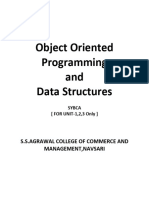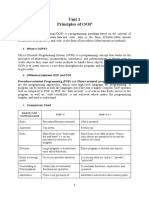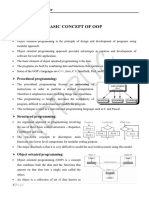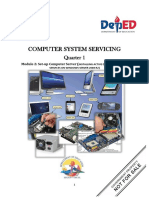0 ratings0% found this document useful (0 votes)
55 viewsObject Oriented Programming
Object-oriented programming (OOP) structures programs around objects rather than functions and logic. OOP focuses on objects that have attributes and functions to represent and manipulate data. Classes act as blueprints that define objects, while abstraction, encapsulation, inheritance, and polymorphism are key concepts. Abstraction hides unnecessary details, encapsulation wraps data and functions together, inheritance establishes a parent-child relationship between classes, and polymorphism allows one function to have multiple definitions. Benefits of OOP include code reusability, easier maintenance through classes and objects, data hiding for security, and ease of implementation.
Uploaded by
Hemil PatoliyaCopyright
© © All Rights Reserved
Available Formats
Download as PPTX, PDF, TXT or read online on Scribd
0 ratings0% found this document useful (0 votes)
55 viewsObject Oriented Programming
Object-oriented programming (OOP) structures programs around objects rather than functions and logic. OOP focuses on objects that have attributes and functions to represent and manipulate data. Classes act as blueprints that define objects, while abstraction, encapsulation, inheritance, and polymorphism are key concepts. Abstraction hides unnecessary details, encapsulation wraps data and functions together, inheritance establishes a parent-child relationship between classes, and polymorphism allows one function to have multiple definitions. Benefits of OOP include code reusability, easier maintenance through classes and objects, data hiding for security, and ease of implementation.
Uploaded by
Hemil PatoliyaCopyright
© © All Rights Reserved
Available Formats
Download as PPTX, PDF, TXT or read online on Scribd
You are on page 1/ 6
Object Oriented Programming
Concept Of Object Oriented
Programming
oop is an approach or a Programming pattern where the programs are
structured around objects rather than functions and logic. It makes the
data partitioned into two memory areas, i.e., data and functions, and
helps make the code flexible and modular.
Object-oriented programming mainly focuses on objects that are
required to be manipulated. In OOPs, it can represent data as objects
that have attributes and functions.
Basic Object-Oriented
Programming
Object-An O Object can be defined as an entity that has a state and
behavior, or in other words, anything that exists physically in the
world is called an object. It can represent a dog, a person, a table,
etc. An object means the combination of data and programs, which
further represent an entity.
Classes-Class can be defined as a blueprint of the object. It is basically
a collection of objects which act as building blocks.
Abstraction- Abstraction helps in the data hiding process. It helps in
displaying the essential features without showing the details or the
functionality to the user. It avoids unnecessary information or
irrelevant details and shows only that specific part which the user
wants to see.
Basic Object-Oriented Programming
Encapsulation- The wrapping up of data and functions together in a single unit is known as
encapsulation. It can be achieved by making the data members' scope private and the member
function’s scope public to access these data members. Encapsulation makes the data non-
accessible to the outside world.
Inheritance- Inheritance is the process in which two classes have an is-a relationship among
each other and objects of one class acquire properties and features of the other class. The class
which inherits the features is known as the child class, and the class whose features it inherited
is called the parent class. For example, Class Vehicle is the parent class, and Class Bus, Car, and
Bike are child classes.
Polymorphism- It means many forms. It is the ability to take more than one form. It is a feature
that provides a function or an operator with more than one definition. It can be implemented
using function overloading, operator overload, function overriding, virtual function.
Advantages of OOPs
There are various advantages of object-oriented programming.
OOPs provide reusability to the code and extend the use of existing
classes.
In OOPs, it is easy to maintain code as there are classes and objects,
which helps in making it easy to maintain rather than restructuring.
It also helps in data hiding, keeping the data and information safe
from leaking or getting exposed.
Object-oriented programming is easy to implement.
You might also like
- Unit-1 (Part-A) Notes of OOPS by Updesh Kumar - UpdatedNo ratings yetUnit-1 (Part-A) Notes of OOPS by Updesh Kumar - Updated29 pages
- Introduction Object-Oriented ProgrammingNo ratings yetIntroduction Object-Oriented Programming67 pages
- What Is Object Oriented Programming? How It Is Differ From Procedure Oriented Programming?No ratings yetWhat Is Object Oriented Programming? How It Is Differ From Procedure Oriented Programming?18 pages
- Unit 1 Principles of OOP: What Is OOPS?No ratings yetUnit 1 Principles of OOP: What Is OOPS?55 pages
- Java New Complete Notes NEP With Programs - ProcessedNo ratings yetJava New Complete Notes NEP With Programs - Processed172 pages
- Module 1_Chapter 1-An-Overview-of-Java-notes (1)No ratings yetModule 1_Chapter 1-An-Overview-of-Java-notes (1)8 pages
- Basic Concepts of Object Oriented ProgrammingNo ratings yetBasic Concepts of Object Oriented Programming3 pages
- Each Person Try To Give An Example For Any Definition, Each Use Unique Example While Answering The Questions. OOPS Interview Questions Part - 1No ratings yetEach Person Try To Give An Example For Any Definition, Each Use Unique Example While Answering The Questions. OOPS Interview Questions Part - 14 pages
- Introduction To Object Oriented Programming: by Megha V Gupta, NHITMNo ratings yetIntroduction To Object Oriented Programming: by Megha V Gupta, NHITM34 pages
- I. Answer The Following: 1. List The Different Rules For Sharing Computer and EquipmentNo ratings yetI. Answer The Following: 1. List The Different Rules For Sharing Computer and Equipment3 pages
- [Ebooks PDF] download Pocket Style Manual 8th Edition A Dianal Hacker & Nancy Sommers full chaptersNo ratings yet[Ebooks PDF] download Pocket Style Manual 8th Edition A Dianal Hacker & Nancy Sommers full chapters19 pages
- Unit 4: Network Topologies and Network Devices (Total Marks-10)No ratings yetUnit 4: Network Topologies and Network Devices (Total Marks-10)20 pages
- What Are The SEO Benefits For Small Business by ProfessionalsNo ratings yetWhat Are The SEO Benefits For Small Business by Professionals3 pages
- MCAN Free College Applications 2022-23 PDFNo ratings yetMCAN Free College Applications 2022-23 PDF1 page
- Unit-1 (Part-A) Notes of OOPS by Updesh Kumar - UpdatedUnit-1 (Part-A) Notes of OOPS by Updesh Kumar - Updated
- What Is Object Oriented Programming? How It Is Differ From Procedure Oriented Programming?What Is Object Oriented Programming? How It Is Differ From Procedure Oriented Programming?
- Java New Complete Notes NEP With Programs - ProcessedJava New Complete Notes NEP With Programs - Processed
- Each Person Try To Give An Example For Any Definition, Each Use Unique Example While Answering The Questions. OOPS Interview Questions Part - 1Each Person Try To Give An Example For Any Definition, Each Use Unique Example While Answering The Questions. OOPS Interview Questions Part - 1
- Introduction To Object Oriented Programming: by Megha V Gupta, NHITMIntroduction To Object Oriented Programming: by Megha V Gupta, NHITM
- A Concise Guide to Object Orientated ProgrammingFrom EverandA Concise Guide to Object Orientated Programming
- I. Answer The Following: 1. List The Different Rules For Sharing Computer and EquipmentI. Answer The Following: 1. List The Different Rules For Sharing Computer and Equipment
- [Ebooks PDF] download Pocket Style Manual 8th Edition A Dianal Hacker & Nancy Sommers full chapters[Ebooks PDF] download Pocket Style Manual 8th Edition A Dianal Hacker & Nancy Sommers full chapters
- Unit 4: Network Topologies and Network Devices (Total Marks-10)Unit 4: Network Topologies and Network Devices (Total Marks-10)
- What Are The SEO Benefits For Small Business by ProfessionalsWhat Are The SEO Benefits For Small Business by Professionals

























































































